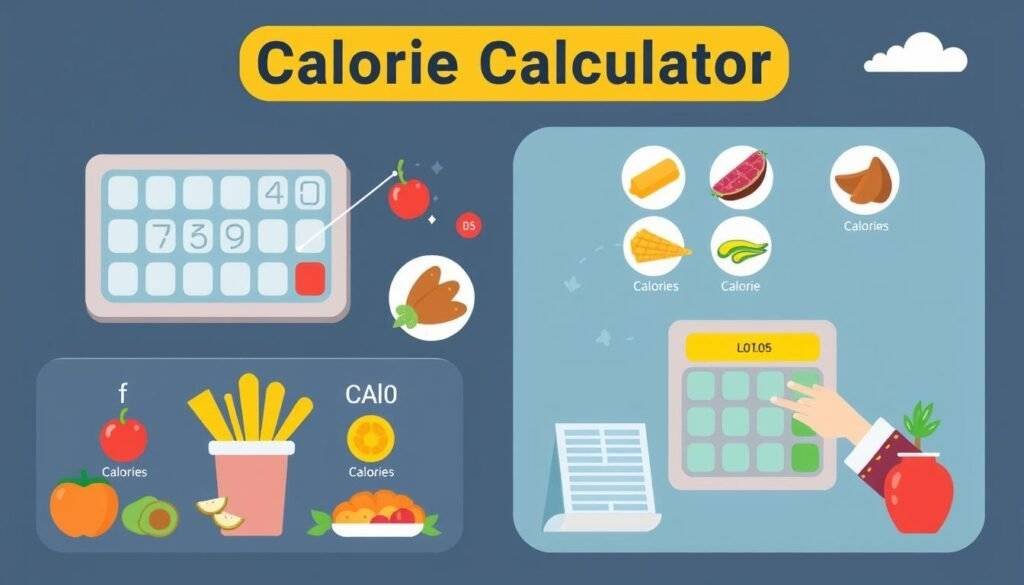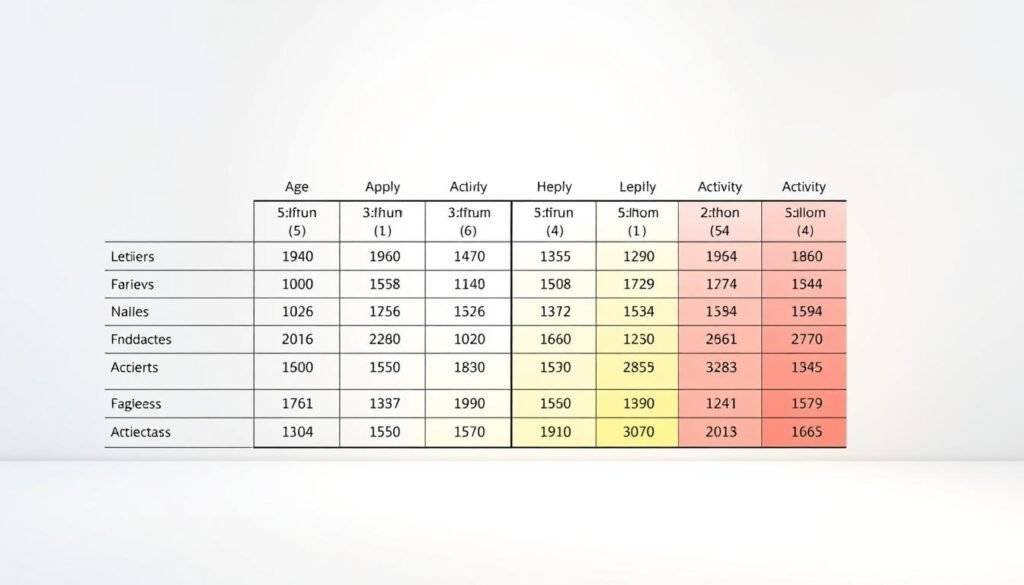Calorie Calculator
Understanding your daily calorie needs is crucial for maintaining a healthy weight. Our comprehensive calorie calculator tool helps you determine the number of calories you need to consume each day based on individual factors like age, gender, weight, height, and activity level.
By using our calculator, you can gain insights into your daily calorie intake and make informed dietary choices. This knowledge is the first step toward achieving your health goals, whether you’re looking to maintain, lose, or gain weight.
Key Takeaways
- Determine your daily calorie needs with our easy-to-use calorie calculator.
- Understand the importance of calorie intake for maintaining a healthy weight.
- Make informed dietary choices based on your personalized calorie requirements.
- Achieve your health goals by knowing your daily calorie needs.
- Create effective nutrition plans tailored to your specific health objectives.
Understanding Your Daily Calorie Needs

Calories are the energy currency of our bodies, and understanding our daily needs is vital. To manage our weight effectively and improve our overall health, we need to grasp how many calories we require daily.
What Are Calories?
Simply put, a calorie is a unit that measures energy. Calories measure the energy content of foods and beverages we consume. Our bodies use this energy to function, from basic metabolic processes to physical activity.
Why Calorie Counting Matters
Understanding and tracking calorie intake is crucial for weight management. The principle is straightforward: to lose weight, we need to consume fewer calories than our body burns each day. This calorie deficit prompts our body to use stored fat for energy.
Factors Affecting Your Calorie Requirements
Several factors influence our daily calorie needs, including age, weight, height, sex, levels of physical activity, and overall general health. Our body‘s composition and metabolism also play significant roles in determining our daily calorie requirements.
By understanding these factors and how they impact our calorie needs, we can better manage our diet and improve our overall health. It’s not just about counting calories; it’s about making informed choices that support our health goals.
How Our Calorie Calculator Works
Our calorie calculator is built on a foundation of scientific research and established formulas to estimate your calorie intake. It utilizes the Mifflin-St Jeor equation, a reliable method for calculating daily energy expenditure.
The Science Behind the Calculator
The science behind our calorie calculator involves using population data and individual factors such as genetics, medications, and lean body mass to estimate calories needs. This approach allows us to provide a personalized estimate of the number calories you need to maintain your weight.
By using established formulas, we can determine your daily calorie intake required to support your body‘s basic functions and adjust for your activity level.
BMR: Your Baseline Calorie Requirement
Basal Metabolic Rate (BMR) represents the calories your body needs at rest to maintain basic functions. Our calculator determines your BMR using the Mifflin-St Jeor equation, providing a baseline for your daily calorie needs.
Activity Levels and Calorie Adjustments
To provide a more accurate estimate, our calorie calculator factors in different activity levels, from sedentary to extremely active. This adjustment ensures that your daily calorie intake is tailored to your lifestyle, supporting your weight maintenance, loss, or gain goals.
By adjusting your calorie recommendations based on your activity level, you can achieve a more accurate estimate of your daily energy expenditure and calories burned.
Calorie Calculator Formulas Explained
To grasp how our calorie calculator works, it’s essential to explore the scientific formulas that power it. The calculator uses several well-established equations to estimate your daily calorie needs.
Mifflin-St Jeor Equation
The Mifflin-St Jeor Equation is a widely used formula for calculating basal metabolic rate (BMR). For men, the formula is BMR = 10 x weight (kg) + 6.25 x height (cm) – 5 x age (years) + 5. For women, it’s BMR = 10 x weight (kg) + 6.25 x height (cm) – 5 x age (years) – 161. This equation has been shown to be more accurate than the older Harris-Benedict Equation.
Harris-Benedict Equation
The Harris-Benedict Equation was one of the earliest formulas used to estimate BMR. Although it’s less accurate than the Mifflin-St Jeor Equation, it holds historical significance. The original Harris-Benedict Equation for men is BMR = 66 + (6.2 x weight in lbs) + (12.7 x height in inches) – (6.8 x age in years), and for women, it’s BMR = 655 + (4.35 x weight in lbs) + (4.7 x height in inches) – (4.7 x age in years).
Katch-McArdle Formula
The Katch-McArdle Formula calculates resting daily energy expenditure (RDEE) based on lean body mass. The formula is RDEE = 370 + (21.6 x lean body mass in kg). This formula is particularly useful for individuals who know their body fat percentage, as it provides a more accurate estimate by considering lean body mass.
Which Formula Is Most Accurate?
The Mifflin-St Jeor Equation is generally considered the most accurate for calculating BMR for most people. However, the Katch-McArdle Formula can be more accurate for individuals who are lean and know their body fat percentage, as it takes into account lean body mass. Our calorie calculator uses these formulas to provide a reliable estimate of your daily calorie needs.
Calorie Needs By Age, Gender, and Activity Level
Your daily calorie needs are determined by several key factors: your age, your gender, and how active you are on a regular basis. Understanding these factors is crucial for managing your weight and overall health.
Calorie Requirements for Women
For women, calorie needs vary across different age groups. According to the 2020-2025 Dietary Guidelines for Americans, women aged 19-30 require about 2,000-2,400 calories per day. As women age, their calorie needs generally decrease due to changes in metabolism and body composition. For instance, women aged 31-60 may need fewer calories, typically in the range of 1,800-2,200 calories daily, while women over 61 may require even less, around 1,600-2,000 calories per day.
Calorie Requirements for Men
Men generally require more calories than women due to higher muscle mass and other factors. For men aged 19-30, the daily calorie requirement is approximately 2,400-3,000 calories. Men aged 31-60 need about 2,200-2,800 calories, and those over 61 require around 2,000-2,600 calories daily. These are general guidelines and can vary based on individual health, body composition, and activity levels.
How Activity Level Impacts Calorie Needs
Activity level significantly impacts your daily calorie needs. For both men and women, being sedentary, lightly active, moderately active, very active, or extremely active changes the number of calories your body burns. For example, someone who is very active may require more calories to maintain their weight compared to someone who is sedentary. The more you move, the more calories you burn, and thus, your calorie needs increase with higher activity levels.

To give you a clearer idea, here is a breakdown of how activity level affects calorie needs across different age groups and genders. Generally, for each activity level category (sedentary, lightly active, etc.), calorie needs are adjusted accordingly. For instance, a very active woman aged 25 might need 2,400 calories, while a sedentary woman of the same age might need only 2,000 calories.
Using the Calorie Calculator for Weight Loss

Our calorie calculator is designed to help you create a personalized plan for weight loss. To achieve your weight loss goals, it’s crucial to understand how to use the calorie calculator effectively.
Creating a Calorie Deficit
To lose weight, you need to eat fewer calories than your body burns each day. Our calorie calculator helps determine the appropriate calorie deficit for your weight loss goals, typically 500-1000 calories below your maintenance level.
Safe Rate of Weight Loss
Aim for a steady and gradual weight loss of about 1-2 pounds per week, as recommended by the CDC. Losing weight at this rate is more sustainable and helps maintain weight loss over time. It’s generally not advisable to lose more than 2 pounds per week, as it can have negative health effects.
Avoiding Common Calorie Counting Mistakes
When counting calories for weight loss, common mistakes include underestimating portion sizes, forgetting to count beverages, or setting unrealistically low calorie goals. To successfully implement a calorie deficit, focus on food choices that promote satiety while keeping calories in check. Regularly recalculating your calorie needs as your weight decreases is also crucial, as your calorie requirements change throughout your weight loss journey.
By using our calorie calculator and following these guidelines, you can create an effective weight loss plan that suits your needs and helps you achieve your goals.
Advanced Calorie Strategies: Zigzag Calorie Cycling
To avoid metabolic adaptation and enhance weight loss, consider implementing a zigzag calorie cycling plan. This advanced dietary strategy involves varying daily calorie intake while maintaining a consistent weekly average, helping to keep the body guessing and potentially overcoming weight loss plateaus.
Defining Zigzag Calorie Cycling
Zigzag calorie cycling is a weight management technique that alternates between high-calorie and low-calorie days. By doing so, it aims to counteract the body’s natural tendency to adapt to a consistent calorie intake, thereby supporting ongoing weight loss efforts.
Benefits of Calorie Cycling
The benefits of zigzag calorie cycling include reduced diet fatigue, as the variation in calorie intake can make the diet feel less restrictive. Additionally, it may help maintain metabolic rate by avoiding the body’s adaptation to a lower calorie level. This approach also offers flexibility for social events or special occasions.
Implementing a Zigzag Approach
To implement zigzag calorie cycling, start by determining your weekly calorie target. Then, allocate your daily calories, varying them significantly from day to day. For example, you might have two high-calorie days, four moderate-calorie days, and one low-calorie day. The key is to balance your overall weekly intake.
| Day | Calorie Intake |
|---|---|
| Monday | 1500 calories |
| Tuesday | 2000 calories |
| Wednesday | 1200 calories |
| Thursday | 1800 calories |
| Friday | 2200 calories |
| Saturday | 1000 calories |
| Sunday | 1600 calories |

Healthy Ways to Reduce Calorie Intake
Lowering your calorie intake doesn’t have to mean deprivation; there are several healthy approaches to achieve this. By making informed dietary choices, we can effectively reduce our calorie consumption without feeling overly restricted.
Focus on Protein-Rich Foods
Increasing protein intake can significantly help in reducing calorie intake. According to a 2020 study, higher protein consumption can enhance satiety, curb appetite, and even help fight cravings. Protein-rich foods like lean meats, fish, eggs, and legumes require more energy to digest, thereby increasing the thermic effect of food and helping in weight loss.
Increase Fiber Consumption
Fiber-rich foods are another crucial component of a calorie-reduced diet. Foods high in fiber, such as fruits, vegetables, and whole grains, promote fullness and slow down digestion, making us feel fuller for longer. They generally contain fewer calories per volume compared to processed foods, making them an ideal choice for those looking to lose weight.
Limit Sugary Beverages
Sugary beverages are a significant source of unnecessary calories. Liquid calories don’t trigger the same fullness signals as solid foods, leading to overconsumption. By limiting or avoiding sugary drinks like soda, sports drinks, and sweetened teas or coffees, we can substantially reduce our daily calorie intake.
Practice Mindful Eating
Mindful eating is a powerful tool for naturally reducing calorie intake. By eating slowly, recognizing hunger and fullness cues, and avoiding distractions during meals, we can develop a healthier relationship with food. This approach helps in consuming fewer calories without the need for strict calorie counting.
| Strategy | Benefits | Examples |
|---|---|---|
| Focus on Protein-Rich Foods | Enhanced satiety, increased thermic effect of food | Lean meats, fish, eggs, legumes |
| Increase Fiber Consumption | Promotes fullness, slows digestion | Fruits, vegetables, whole grains |
| Limit Sugary Beverages | Reduces unnecessary calorie intake | Avoid soda, sports drinks, sweetened teas/coffees |
| Practice Mindful Eating | Develops a healthier relationship with food | Eat slowly, recognize hunger/fullness cues |
Conclusion: Beyond Calories – The Complete Picture of Health
As we conclude our exploration of calorie calculation and its role in weight management, it’s clear that a holistic approach is necessary for achieving optimal health. While counting calories can be an effective strategy for weight loss, it’s essential to consider the broader context of nutrition and overall well-being.
Our discussion has highlighted that calorie intake is just one factor among many that influence weight and health. Nutrient density, muscle mass, activity level, and overall lifestyle choices play significant roles in determining health outcomes. Focusing solely on calories can lead to neglect of other critical aspects, such as the quality of the diet and regular physical activity.
A balanced diet rich in whole, nutritious foods, combined with regular exercise and healthy lifestyle habits, is key to achieving and maintaining a healthy weight. It’s also important to recognize that individual factors such as genetics, age, and health conditions can impact weight loss efforts. Therefore, a personalized approach, potentially guided by healthcare professionals, is often the most effective.
Using our calorie calculator as a starting point can help individuals develop a tailored nutrition plan that suits their unique needs and goals. By adopting sustainable and gradual changes, rather than extreme restrictions, individuals are more likely to achieve long-term success in their health and weight loss journeys.
In conclusion, while calorie management is important, it’s just one aspect of a comprehensive approach to health. By considering the interplay between diet, activity level, and overall lifestyle, individuals can work towards achieving optimal health and a healthy weight.
FAQ
How many calories should I consume daily to maintain my weight?
The number of calories you need to maintain your weight depends on several factors, including your age, gender, weight, height, and activity level. We use the Mifflin-St Jeor Equation, Harris-Benedict Equation, or Katch-McArdle Formula to estimate your daily calorie needs.
What is the difference between calorie intake and energy expenditure?
Energy expenditure refers to the number of calories your body burns to function, while calorie intake is the number of calories you consume through food and drinks. To lose weight, your energy expenditure should be greater than your calorie intake, creating a calorie deficit.
How does my activity level impact my calorie needs?
Your activity level plays a significant role in determining your daily calorie needs. The more active you are, the more calories you burn. We consider your activity level when calculating your daily calorie requirements to ensure you’re consuming enough energy to support your lifestyle.
Can I use the calorie calculator for weight loss?
Yes, you can use our calorie calculator to determine your daily calorie needs for weight loss. By creating a calorie deficit, you can safely lose weight at a rate of 1-2 pounds per week.
What is lean body mass, and how does it affect my calorie needs?
Lean body mass refers to your body weight minus your body fat. It is a significant factor in determining your resting metabolic rate, as it indicates the amount of energy your body needs to function at rest.
How can I increase my metabolism to burn more calories?
You can boost your metabolism by incorporating intense exercise and muscle-building activities into your routine, as well as consuming enough protein-rich foods to support muscle growth.

